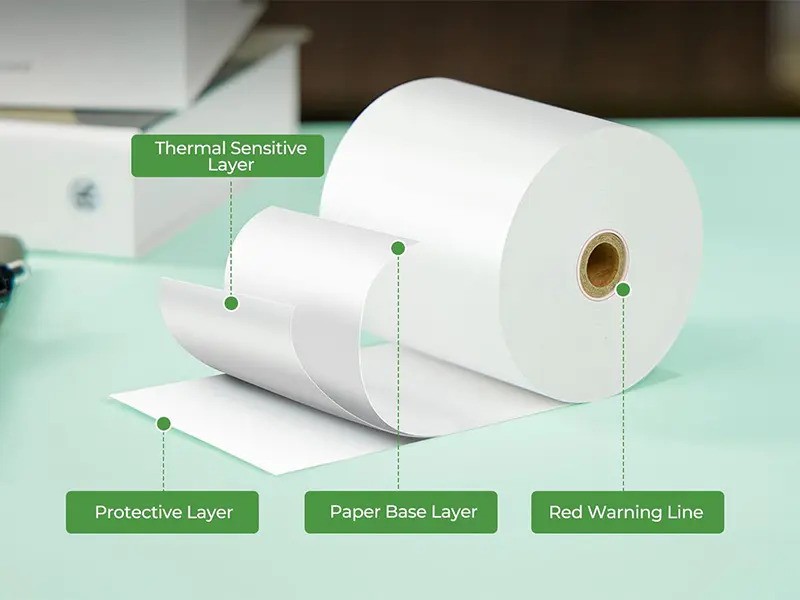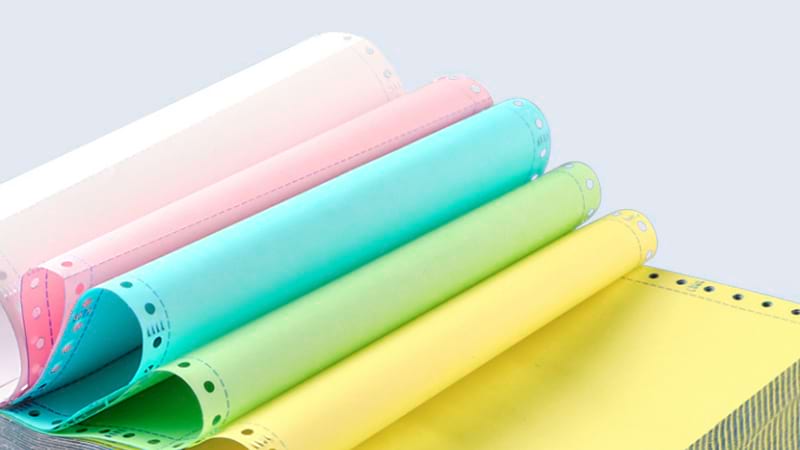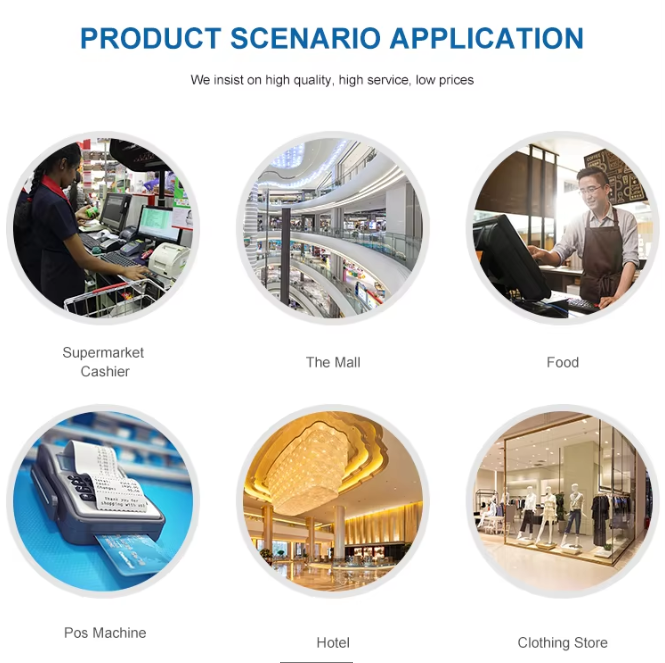
Thermal Paper vs Carbonless Paper—Which one is right for your business? Whether you’re printing receipts, invoices, or shipping labels, choosing the right paper type impacts cost, efficiency, and durability. While thermal paper uses heat-sensitive coating for fast, ink-free printing, carbonless paper creates multiple copies without messy carbon sheets. But which one best suits your needs?
In this post, we’ll explore the key differences between thermal and carbonless paper, their advantages, industry applications, and factors to consider before making a decision. By the end, you’ll know exactly which paper type aligns with your business requirements.
What is Thermal Paper?
Thermal paper is a special type of coated paper designed for heat-based printing. Unlike traditional paper, it doesn’t require ink, toner, or ribbons. Instead, it reacts to heat, making it a fast and cost-effective choice for receipts, labels, and tickets.
How Thermal Paper Works
Thermal paper has a chemical coating that turns dark when exposed to heat. This process happens inside a direct thermal printer, which uses a heated printhead to create images or text.

Components of a Thermal Printer:
Thermal Printhead – Applies heat to activate the paper’s coating.
Platen Roller – Feeds the paper through the printer.
Controller Board – Manages the heat intensity and printing precision.
Characteristics of Thermal Paper
Thermal paper is designed for high-speed printing and clear, smudge-free output. Here’s what makes it unique:
| Feature | Description |
| Structure | Single-ply, lightweight |
| Finish | Smooth, glossy surface for sharp prints |
| Heat Sensitivity | Fades over time when exposed to heat, light, or moisture |
| Common Colors | White (most common), blue, red |
Pros and Cons of Thermal Paper
Advantages:
✅ Ink-free printing – No need for ink, toner, or ribbons.
✅ Fast and efficient – Ideal for high-volume printing needs.
✅ Low maintenance – Fewer moving parts, reducing mechanical issues.
✅ Widely used – Found in POS systems, ATMs, medical imaging, and more.
Disadvantages:
❌ Prints fade – Heat, light, and humidity can erase text over time.
❌ Special storage required – Must be kept in cool, dark places.
❌ Chemical concerns – Some papers contain BPA/BPS, raising environmental and health issues.
Types of Thermal Paper
Not all thermal paper is the same. Depending on durability needs, businesses use different types:
Standard Thermal Paper – Common for receipts, shipping labels, and event tickets.
Top-Coated Thermal Paper – Has a protective layer to resist moisture, light, and scratches.
Synthetic Thermal Paper – Waterproof and tear-resistant, used in industrial and outdoor settings.
What is Carbonless Paper?
How Carbonless Paper Works
Carbonless paper uses a pressure-sensitive microcapsule coating that reacts when force is applied. Each layer of the paper has a specific role in transferring the text or image from the top sheet to the lower sheets.
CB (Coated Back): The top layer contains microcapsules on the back. When pressure from a pen or printer is applied, these capsules break, releasing dye.
CFB (Coated Front and Back): The middle sheet has a coated front to receive dye from the top sheet and a coated back to pass the impression further to the next sheet.
CF (Coated Front): The bottom layer has a chemical coating that reacts with the dye, forming the final copy.
Example: When filling out an invoice, the pressure applied from a pen on the top sheet triggers the dye to transfer through the layers, instantly creating multiple copies.
Characteristics of Carbonless Paper

100% wood pulp White Pink Yellow NCR paper(carbonless paper)
Carbonless paper is designed for practical use in multi-copy printing and offers several specific characteristics:
Multi-Ply Options: Available in 2-ply, 3-ply, and 4-ply formats to create one or more copies in a single write.
Impact Printing Compatibility: Suitable for dot matrix printers and other impact printers that apply mechanical pressure. It also works well with handwritten applications.
Instant Copy Creation: Produces multiple copies without needing additional equipment like scanners or photocopiers.
Color-Coded Layers: Typically, carbonless paper uses white for the top layer, followed by canary yellow, pink, or blue for subsequent copies to differentiate between copies.
| Ply Type | Number of Copies | Common Use Cases |
| 2-Ply | 1 Copy | Sales Receipts, Invoices |
| 3-Ply | 2 Copies | Delivery Notes, Work Orders |
| 4-Ply | 3 Copies | Legal Documents, Manufacturing Orders |
Pros and Cons of Carbonless Paper
✅ Advantages
No Carbon Mess: Clean and efficient, with no black carbon residue.
Long-Lasting Impressions: Prints don’t fade as easily compared to thermal paper.
Multiple Copies in One Go: Ideal for businesses needing duplicates for records and clients.
Environmentally Friendly: Often recyclable and free from harmful chemicals.
❗ Disadvantages
Printer Requirements: Requires impact or dot matrix printers, which are bulkier and more expensive.
Slower Printing Speed: Compared to thermal paper, printing is slower.
Higher Initial Cost: Multi-ply paper is generally more expensive upfront.
Potential Smudging: If mishandled, the dye may smudge under extreme pressure.
Types of Carbonless Paper
Depending on the specific printing setup and requirements, businesses can choose from the following types of carbonless paper:
Pre-Collated Carbonless Paper:
Reverse-Collated Carbonless Paper:
Self-Contained Carbonless Paper:
Tip: For large-scale printing operations, pre-collated paper saves time and reduces the risk of human error.
Key Differences Between Thermal and Carbonless Paper
1. Printing Mechanism
Thermal Paper
Thermal paper uses a heat-sensitive chemical coating that darkens when exposed to heat. The thermal printer’s heated printhead selectively applies heat to specific areas, forming crisp black images without using ink, toner, or ribbons. This simple mechanism makes thermal printing a low-maintenance and fast option, especially for businesses handling high print volumes.
Carbonless Paper
In contrast, carbonless paper employs a pressure-sensitive microcapsule coating. When pressure is applied, whether from a pen or impact printer, microcapsules break and release dye, creating duplicates without the mess of carbon sheets. While this method requires ink ribbons or toner for the first layer, it is invaluable for industries needing multiple copies in one go.
2. Durability and Longevity
The longevity of printed materials depends on how well they withstand environmental factors like light, heat, and moisture.
| Factor | Thermal Paper | Carbonless Paper |
| Fading | Prints fade when exposed to heat, light, or moisture | Prints remain legible for over 10 years |
| Archival Suitability | Not suitable for long-term archiving | Ideal for legal and financial record-keeping |
| Environmental Impact | Requires controlled storage environments | Withstands normal office conditions |
3. Cost Comparison
Thermal Paper
Thermal paper is generally cheaper upfront as it requires no ink, ribbons, or toner. The lower maintenance costs of thermal printers further contribute to cost savings. However, businesses using thermal paper must frequently replace paper rolls, especially in high-traffic industries like retail or hospitality, resulting in ongoing expenses.
Carbonless Paper
Carbonless paper has a higher initial cost due to its multi-layer design. Additionally, impact printers used for carbonless printing require regular ribbon or toner replacements, increasing operational costs. However, because carbonless copies provide permanent, high-quality records, it reduces the need for reprints and enhances long-term cost-effectiveness.
4. Usability in Different Industries
| Industry | Thermal Paper | Carbonless Paper |
| Retail & Hospitality | Fast POS receipts, barcode labels, and order tickets | Rarely used |
| Banking & Finance | ATM receipts, account statements | Contracts, invoices, and multi-copy documents |
| Healthcare | Prescription labels, test results | Patient admission forms and medical reports |
| Logistics & Transportation | Shipping labels, tracking barcodes | Delivery receipts, driver logs, and shipping reports |
| Legal & Accounting | Not preferred | Ideal for contracts, forms, and financial records |
5. Environmental Impact
Thermal Paper
Thermal paper can pose environmental concerns due to its use of BPA (Bisphenol A) or BPS (Bisphenol S). These chemicals make recycling difficult and can be harmful to human health and the environment. However, many manufacturers now offer BPA-free thermal paper options that are safer and easier to recycle.
Carbonless Paper
Carbonless paper is generally considered more eco-friendly. It is typically recyclable and does not contain hazardous chemicals. Some manufacturers also produce carbonless paper from recycled materials, further reducing environmental impact. Businesses aiming for sustainability often prefer carbonless paper for documentation purposes.
6. Storage and Shelf Life
Proper storage is crucial to maintaining the quality and readability of printed documents.
| Storage Factor | Thermal Paper | Carbonless Paper |
| Temperature Sensitivity | Highly sensitive to heat; may cause fading | Not significantly affected by temperature |
| Humidity Impact | Can smudge or fade in high humidity | Remains stable in most environments |
| Storage Duration | Lasts 3-5 years with proper storage | Can last over 10 years without fading |
| Best Storage Practice | Cool, dark, and dry place | Standard filing cabinets are sufficient |
Applications of Thermal and Carbonless Paper
Industries Using Thermal Paper
Thermal paper’s quick printing and low-maintenance benefits make it a popular choice in sectors requiring instant documentation.

Retail
Widely used for point-of-sale (POS) receipts at stores and restaurants.
Barcode labels are printed on thermal paper for easy inventory tracking.
Self-checkout systems rely heavily on thermal printers for efficient service.
Banking
ATM receipts provide customers with a record of transactions.
Banks print transaction logs and internal reports using thermal paper.
Faster printing ensures less waiting time for clients.
Healthcare
Prescription labels are often printed on thermal paper for pharmacies.
Hospitals and clinics maintain patient records using thermal labels.
Laboratories rely on thermal paper for clear, durable barcode labels.
Logistics
Shipping companies print shipping labels for packages.
Warehouse tracking uses thermal paper for inventory management.
Delivery services print waybills for seamless order tracking.
| Industry | Common Use | Benefits |
| Retail | POS Receipts, Barcode Labels | Quick printing, low maintenance |
| Banking | ATM Receipts, Transaction Logs | Fast service, clear documentation |
| Healthcare | Prescription Labels, Records | Accurate data, easy scanning |
| Logistics | Shipping Labels, Tracking | Efficient package management |
Industries Using Carbonless Paper
Accounting & Finance
Invoices and receipts are often printed on 2-ply or 3-ply carbonless forms.
Contracts and financial agreements use carbonless paper for authorized signatures.
Auditors and accountants rely on duplicates for accurate record-keeping.
Logistics & Transportation
Shipping receipts and delivery confirmations require multiple copies.
Carbonless paper is essential for driver logs and consignment notes.
Ensures both the business and the customer have identical documentation.
Government & Legal
Legal contracts and official forms are often created with carbonless paper.
Agencies maintain detailed archival records for long-term storage.
Court proceedings frequently involve multi-copy forms for clear documentation.
Manufacturing
Work orders are printed on carbonless forms for seamless communication.
Quality control documents use multi-copy sheets to ensure proper tracking.
Technicians and managers keep copies of maintenance and inspection reports.
| Industry | Common Use | Benefits |
| Accounting & Finance | Invoices, Contracts | Reliable copies, clear records |
| Logistics & Transportation | Shipping Receipts, Delivery Notes | Ensures accountability, easy tracking |
| Government & Legal | Contracts, Archival Records | Long-lasting copies, legal validity |
| Manufacturing | Work Orders, Quality Documents | Error reduction, improved oversight |
Factors to Consider When Choosing Between Thermal and Carbonless Paper
Business Needs and Printing Requirements
| Factor | Thermal Paper | Carbonless Paper |
| Printing Frequency | Best for frequent, high-speed printing | Ideal for low to moderate printing |
| Number of Copies | Single copy per print | Multiple copies per print |
| Upfront Costs | Low | Higher due to multi-ply sheets |
| Maintenance Costs | Low | Higher due to ribbon or ink use |
Longevity and Storage Considerations
Document Preservation Needs
Thermal paper prints tend to fade within a few years if exposed to heat, light, or moisture.
Carbonless paper provides long-term durability, making it suitable for contracts and records that need to be archived.
Environmental Conditions
Thermal paper is highly sensitive to temperature and humidity.
Carbonless paper maintains its quality in standard office environments without special storage requirements.
For areas with fluctuating temperatures, carbonless paper is the better choice.
Printer Compatibility
Thermal Printers
Best for high-speed, high-volume operations.
No ink or ribbons required.
Ideal for retail, banking, and hospitality where speed is essential.
Impact Printers
Required for carbonless paper printing.
Uses ink ribbons or toner to apply pressure for creating copies.
Suitable for businesses handling invoices, receipts, or legal documents.
| Printer Type | Best For | Maintenance |
| Thermal Printer | Fast-paced, high-volume printing | Low maintenance, no ribbons |
| Impact Printer | Multi-copy documents, record-keeping | Requires ribbon and ink upkeep |
Conclusion
Choosing between thermal and carbonless paper depends on your business needs. Thermal paper is ideal for fast, cost-effective printing in retail, banking, and healthcare. Meanwhile, carbonless paper offers long-lasting, multi-copy documentation for industries like finance, logistics, and legal services. Evaluate your priorities to make the right choice.
Looking for the best paper solution? Opt for thermal paper for speed and convenience or choose carbonless paper for durable, multi-copy records. Assess your industry needs and budget, then invest in the paper type that ensures operational efficiency. Make an informed decision and streamline your business processes today!
FAQs
1. Does thermal paper require ink?
No, thermal paper uses a heat-sensitive coating that darkens when exposed to heat, eliminating the need for ink, toner, or ribbons.
2. Why do thermal receipts fade?
Thermal receipts fade due to exposure to heat, light, or humidity. The chemical coating reacts over time, causing text to disappear or become unclear.
3. Can thermal paper be recycled?
Recycling thermal paper can be challenging since some types contain BPA or BPS. However, BPA-free versions are more environmentally friendly and easier to recycle.
4. How long does carbonless paper last?
Carbonless paper can last for 10 years or more when stored in a cool, dry place. It's ideal for long-term record-keeping and archival purposes.




























